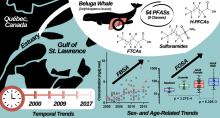| Title | Structure and Toxicity Characterization of Alkyl Hydroxylated Metabolites of 6PPD-Q. |
| Publication Type | Journal Article |
| Year of Publication | 2025 |
| Authors | Nair, P, Barrett, H, Tanoto, K, Xie, L, Sun, J, Yang, D, Yao, H, Song, D, Peng, H |
| Journal | Environ Sci Technol |
| Date Published | 2025 Apr 08 |
| ISSN | 1520-5851 |
| Abstract | Distinct from other nontoxic phenyl--phenylenediamine (PPD) quinones, -(1,3-dimethylbutyl)-'-phenyl--phenylenediamine-quinone (6PPD-Q) was recently discovered to be regioselectively metabolized to alkyl hydroxylated metabolites (alkyl-OH-6PPD-Q) in rainbow trout. It remains unknown whether the unique alkyl-OH-6PPD-Q contributes to the toxicity of 6PPD-Q. To test this, we herein synthesized chemical standards of alkyl-OH-6PPD-Q isomers and investigated their metabolic formation mechanism and toxicity. The predominant alkyl-OH-6PPD-Q was confirmed to be hydroxylated on the C tertiary carbon (C-OH-6PPD-Q). The formation of C-OH-6PPD-Q was only observed in microsomal but not in cytosolic fractions of rainbow trout () liver S9. A general cytochrome P450 (CYP450) inhibitor fluoxetine inhibited the formation of hydroxylated metabolites of 6PPD-Q, supporting that CYP450 catalyzed the hydroxylation. This well-explained the compound- and regio-selective formation of C-OH-6PPD-Q, due to the weak C-H bond on the C tertiary carbon. Surprisingly, while cytotoxicity was observed for 6PPD-Q and C-OH-6PPD-Q in a coho salmon () embryo (CSE-119) cell line, no toxicity was observed for C-OH-6PPD-Q. To further confirm this under physiologically relevant conditions, we fractionated 6PPD-Q metabolites formed in the liver microsome of rainbow trout. Cytotoxicity was observed for the fraction of 6PPD-Q, but not the fraction of C-OH-6PPD-Q. In summary, this study highlighted the C tertiary carbon as the key moiety for both metabolism and toxicity of 6PPD-Q and confirmed that alkyl hydroxylation is a detoxification pathway for 6PPD-Q. |
| DOI | 10.1021/acs.est.4c11823 |
| Alternate Journal | Environ Sci Technol |
| PubMed ID | 40197020 |
Environmental Chemical Biology

